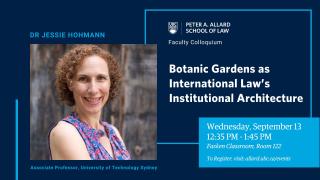Event Description:
For most people, a stroll through a botanic garden is a pleasant way to spend an afternoon. The botanic garden is experienced as a place of leisure and relaxation, a cultivated green space created and maintained ‘for the people’s pleasure’. In this sense, botanic gardens appear as neither architecture, nor spaces of international law, and few visitors would leave the botanic garden impressed by, perhaps even conscious of, their encounter with international law.
But Botanic gardens are spaces where international law is busily at work. Botanic gardens were key to the colonial project, and accordingly to the spread of European international law’s dominance across the entire globe, as well as to the development of international legal regimes. Botanic gardens remain at the centre of a number of international legal efforts: for example, to preserve biodiversity and to combat climate change.
In this paper, part of a broader project on Understanding Australia’s relationship with International Law through its Botanic Gardens and their Plant Collections, I argue that we should understand botanic gardens as international law’s architecture. I develop the argument through the example of the Royal Botanic Gardens, Sydney which is located on the lands of the Gadigal People of the Eora Nation, established as the first colonial farm, and subsequently the botanic garden in the heart of Sydney’s central business district.
The Allard School of Law Faculty Colloquium Series features research talks and discussions by faculty members and invited speakers. This series is divided into a series of public talks and faculty-only discussions. All are welcome to join in the public talks.
Speaker:

Jessie Hohmann joined UTS Faculty of Law as Associate Professor in 2019. She is an internationally recognised expert on the right to housing in international law. Her research also engages with the material culture, objects and materiality of international law, and with Indigenous Peoples and international law. Her 2013 monograph The Right to Housing: Law, Concepts, Possibilities (Hart) was shortlisted for the Society of Legal Scholars Peter Birks Prize for Outstanding Legal Scholarship. She is also the editor of Hohmann and Joyce (eds) International Law Objects (OUP 2018) and Hohmann and Weller (eds) The UN Declaration on the Rights of Indigenous Peoples: A Commentary (OUP 2018). Before joining UTS she was Senior Lecturer in Law at Queen Mary, University of London (2012-2019), and held a British Academy Post-Doctoral Fellowship at the University of Cambridge (2009-2012). She held an Independent Social Research Foundation Early Career Fellowship, pursuing research on the materiality and objects of international law in 2017-18.
Jessie has two current major research projects. First a project on ‘Understanding Australia’s Relationship with International Law through its Botanic Gardens and their Plant Collections’. This builds on her earlier work on objects and material culture and seeks to use a novel method and entry point for new scholarly, and public, understandings of international law’s work in the world. Second, she is working on a book on Housing and Human Rights, broadening her earlier focus on the right to housing to tackle the multiple intersections between the law and political economy of housing.
- Allard School of Law
- General Public
- Research Talks
